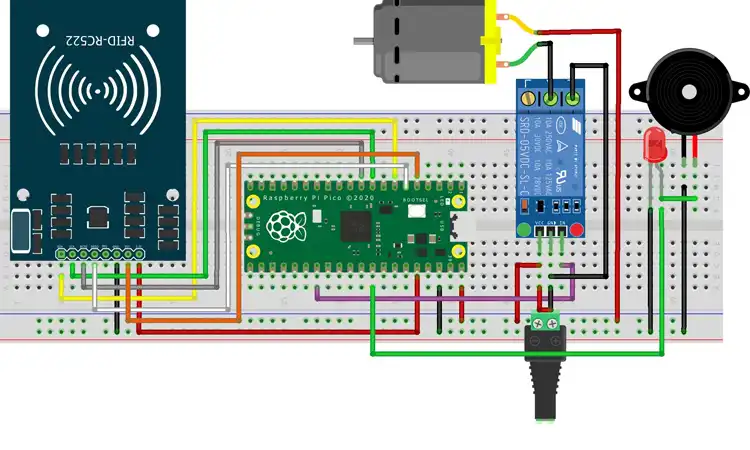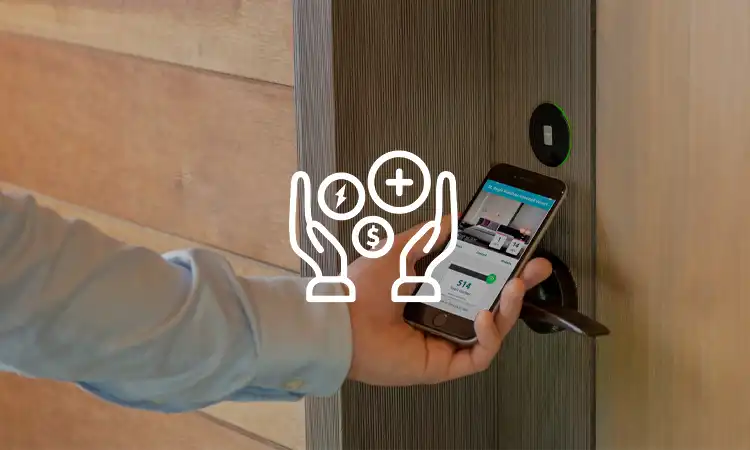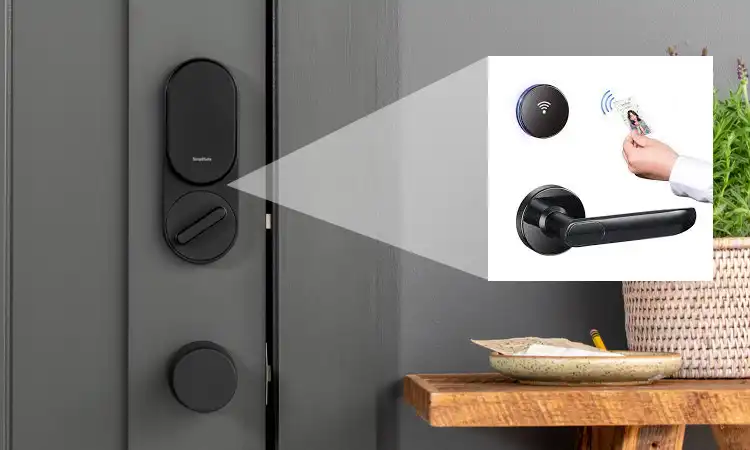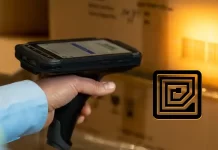Are you looking to upgrade your home or office’s security? Consider switching to RFID door locks. With their advanced technology, RFID locks offer a range of benefits that traditional locks simply can’t match.
What is RFID Door Lock?
RFID door locks are electronic locks that use radio frequency identification technology to grant access to a secured area. The system consists of two parts: a reader and a tag. The reader sends a signal, and a tag attached to the key fob or fob responds to the signal. The tag then sends a signal back to the reader, which verifies the information and unlocks the door if the tag is authorized.
The technology used in RFID door locks is like that used in credit cards and passports, which contain RFID chips that send information when scanned. The chips in RFID door locks are powered by the electromagnetic field generated by the reader, so they do not require batteries. This makes them low-maintenance and long-lasting.
RFID locks can be programmed to allow or restrict access based on various factors, including time of day, day of the week, and the individual’s level of clearance. They are often used in commercial and industrial settings, such as office buildings, hospitals, and government facilities. They can also be used in residential settings like apartment buildings and smart homes.
RFID Door Lock Components

RFID door locks comprise several components that provide secure and convenient access control. Here are the main components of an RFID door lock:
- RFID Reader: The RFID reader is the device that communicates with the RFID tag to authenticate the user and unlock the door. The reader is typically installed on the door’s exterior and can be designed as a standalone device or integrated into a larger access control system.
- RFID Tag: The RFID tag is a small electronic device attached to a key fob or card and contains a unique identifier that the RFID reader can recognize. When the RFID tag is presented to the reader, it sends a signal processed by the access control system to grant or deny access.
- Lock Mechanism: The lock mechanism is the physical component that secures the door and prevents unauthorized entry. Depending on the type of door and security requirements, the lock mechanism can include a deadbolt, latch, or other locking mechanism.
- Power Supply: The RFID door lock system requires a power supply to operate the RFID reader and lock mechanism. This can be provided through a hardwired connection or a battery-powered system.
- Control Panel: The control panel is the brain of the access control system. It manages the authentication process, communicates with the RFID reader and lock mechanism, and stores user access data.
- Software: The interface allows administrators to manage user access, set permissions, and track activity. This can be a standalone software application or part of a larger security management system.
The components of an RFID door lock work together to provide a secure and convenient access control system tailored to an organization’s specific needs.
RFID Door Locks Application
RFID lock for door have many applications and are commonly used in hotels, office buildings, and other settings where security and access control are a priority. Here are a few notable use cases and studies:
- Marriott Hotels: Marriott International has implemented RFID hotel door locks in several hotels worldwide. In addition to providing added security for guests and employees, the RFID locks have also helped reduce the time it takes guests to check in and access their rooms. A study conducted by the hotel chain found that RFID-enabled check-in reduced the time it took to check in by 70%.
- Google: The technology giant Google has also implemented RFID door locks in several office buildings. The locks are used to restrict access to certain areas of the building, as well as to track employee movements and manage visitor access. In addition to improving security, the RFID locks have also helped streamline access control processes, reducing administrative costs and improving operational efficiency.
- Hospitals: Many hospitals have implemented RFID door locks to improve security and access control in patient care areas. For example, the University of Kansas Medical Center implemented an RFID-based access control system in its neonatal intensive care unit. The system uses RFID-enabled wristbands to control unit access and monitor staff and visitors’ movements.
- University of California: The University of California has implemented RFID door locks in several campus buildings, including dormitories and academic buildings. The locks are used to restrict access to certain areas of the building, as well as to track student movements and manage visitor access. A study conducted by the university found that RFID locks improved security and reduced the incidence of theft and vandalism.
These use cases and studies demonstrate the versatility and effectiveness of RFID door locks in various settings. From hotels to hospitals to universities, RFID locks are helping to improve security, streamline access control processes, and reduce costs.
RFID Door Lock VS Traditional Door Lock VS Smart Door Lock VS Biometric Door Lock
Here’s a table comparing RFID locks, traditional locks, smart locks, and biometric locks:
| Lock Type | Description | Pros | Cons |
|---|---|---|---|
| RFID Locks | Use radio frequency identification technology to control access | Convenience, enhanced security, access control | Expensive upfront cost, reliance on technology |
| Traditional Locks | Use mechanical systems with a physical key to secure doors | Proven track record of reliability, less expensive | Vulnerable to physical manipulation, difficult to manage and maintain |
| Smart Locks | Use digital technology to control access, often integrated with other smart home systems | Convenience, remote access control, easy integration | Vulnerable to hacking, can be unreliable |
| Biometric Locks | Use a person’s unique biological characteristics, such as fingerprints or facial recognition, to control access | High security, no risk of lost or stolen keys | Expensive, potential issues with accuracy and reliability |
Note that this is just a general overview of these lock types and there may be additional pros and cons depending on the specific brand or model. It’s also important to consider other factors such as installation, maintenance, and compatibility with existing systems when choosing a lock type.
Wireless RFID locks Benefits

Wireless RFID locks offer many benefits over traditional wired locks, including increased convenience, flexibility, and accessibility. Here are some of the key advantages of wireless RFID locks:
- Easy installation: Wireless RFID locks are typically easier and faster to install than traditional wired locks since there is no need to run wires or cables between the lock and control panel.
- Enhanced accessibility: With wireless RFID locks, users can often access the lock remotely using a smartphone or other mobile device. This can be especially useful for remote monitoring and management of access control systems.
- Increased flexibility: Wireless RFID locks are highly flexible and adaptable, allowing for quick changes to access control settings and user permissions. This can be particularly useful in high-traffic areas where frequent changes to access rights may be needed.
- Improved security: Wireless RFID locks can provide enhanced security features. Such as automatic lockout, intrusion detection, and real-time alerts for unauthorized access attempts.
- Lower maintenance costs: Wireless RFID locks can be less expensive to maintain over time since there are no wires or cables to maintain or replace.
- Integration with other systems: Wireless RFID locks can be easily integrated with other security and access control systems. These include CCTV cameras, alarm systems, and building management systems.
- Increased scalability: Wireless RFID locks are highly scalable. It makes it easy to add or remove locks as needed and to expand the system over time as the organization grows.
Wireless RFID locks offer a range of benefits that can help to improve security and accessibility while reducing maintenance and installation costs. As such, they are a popular choice for organizations of all sizes, from small businesses to large corporations.
Safety Considerations for RFID Door Locks and Readers
There are many security considerations to keep in mind when it comes to RFID door locks and readers. While RFID locks can provide enhanced security and access control, they are also vulnerable to certain types of attacks and exploits.
One of the primary security concerns with RFID locks is the potential for unauthorized access or cloning of RFID credentials. If an attacker can intercept or copy the RFID signal, they may be able to gain entry to a secured area. This can be mitigated By using encryption and other security measures to protect the RFID signal and ensure that only authorized users can access the system.
Another concern is the possibility of RFID skimming, where an attacker uses a device to intercept the RFID signal and steal the credentials stored on the tag. This can be prevented by using RFID tags with more secure encryption and by keeping the tags shielded or in a secure location when not in use.
Physical security is also a concern with RFID door locks and readers. If an attacker can physically access the RFID reader or wiring, they may be able to bypass the system and gain entry. This can be prevented by keeping the reader in a secure location and using tamper-resistant or tamper-evident components.
It’s also important to ensure the RFID system is properly configured and maintained to prevent other potential security risks. Such as system failures or misconfigurations that may leave the system vulnerable to attack.
Overall, while RFID door locks and readers can provide enhanced security and access control, it’s important to carefully consider and address potential security risks to ensure the system is as secure as possible. This can be done through encryption, secure RFID tags, physical security measures, and proper configuration and maintenance of the system.
Install an RFID Door Lock System Cost
The cost of installing an RFID door lock system can vary widely, depending on several factors. Examples include the size and complexity of the system, the type of hardware and software required, and the level of customization required. Here are some factors to consider when estimating the cost of an RFID door lock system installation:
- Hardware: The RFID door lock hardware cost is one of the main expenses in the installation process. Depending on the brand, features, and technology used, prices can range from $50 to $500 or more per lock.
- Software: Besides the hardware, software costs may be associated with the installation. Such as access control management software or integration with other security systems. These costs can range from a few hundred to several thousand dollars.
- Installation: The installation costs will depend on the size and complexity of the system and door location and accessibility. Installation costs can range from a few hundred to several thousand dollars per door.
- Customization: If the system requires custom programming or hardware modifications, this can add to the overall cost of the installation. The level of customization needed will depend on the specific needs of the organization and the capabilities of the RFID door lock system.
- Maintenance: Ongoing maintenance costs can also add to the overall cost of the installation. These may include software updates, hardware repairs or replacements, and other maintenance tasks.
In general, the cost of installing an RFID door lock system can range from a few hundred to several thousand dollars per door. This depends on the organization’s specific needs and the system’s complexity. However, the benefits of enhanced security, convenience, and accessibility that RFID door locks provide can make them a worthwhile investment for many organizations.
RFID door lock offer several advantages over traditional locking mechanisms, including convenience, security, and cost-effectiveness. RFID locks for door are becoming increasingly popular in various industries with the ability to integrate with other security systems and remotely manage access. As technology continues to evolve, we can expect to see even more innovative applications of RFID door lock systems in the future.











